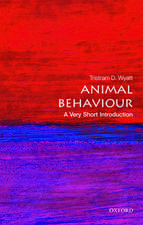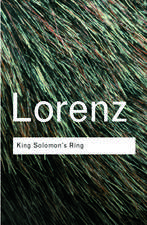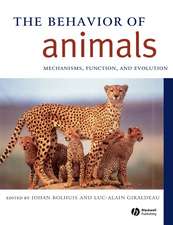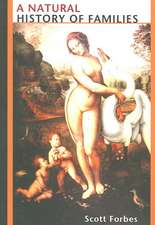Indonesian Primates: Developments in Primatology: Progress and Prospects
Editat de Sharon Gursky-Doyen, Jatna Supriatnaen Limba Engleză Paperback – 4 mai 2012
Partly in response to the number of primates distributed throughout the Indonesian archipelago, Indonesia is classified as the home of two biodiversity hotspots (Wallacea and Sundaland). In order to be classified as a hotspot, an area must have a large proportion of endemic species coupled with a high degree of threat including having lost more than 70% of its original habitat. Two areas within Indonesia meet these criteria. The tremendous diversity of primates in Indonesia, in conjunction with the conservation issues facing the primates of this region, created a need for this volume.
| Toate formatele și edițiile | Preț | Express |
|---|---|---|
| Paperback (1) | 1549.67 lei 6-8 săpt. | |
| Springer – 4 mai 2012 | 1549.67 lei 6-8 săpt. | |
| Hardback (1) | 1554.26 lei 6-8 săpt. | |
| Springer – 19 feb 2010 | 1554.26 lei 6-8 săpt. |
Din seria Developments in Primatology: Progress and Prospects
- 20%
 Preț: 571.31 lei
Preț: 571.31 lei - 18%
 Preț: 1216.65 lei
Preț: 1216.65 lei - 19%
 Preț: 578.66 lei
Preț: 578.66 lei - 18%
 Preț: 956.69 lei
Preț: 956.69 lei - 18%
 Preț: 948.92 lei
Preț: 948.92 lei - 18%
 Preț: 948.92 lei
Preț: 948.92 lei - 18%
 Preț: 945.79 lei
Preț: 945.79 lei - 18%
 Preț: 962.66 lei
Preț: 962.66 lei - 18%
 Preț: 1664.43 lei
Preț: 1664.43 lei - 18%
 Preț: 1224.54 lei
Preț: 1224.54 lei - 24%
 Preț: 826.25 lei
Preț: 826.25 lei - 24%
 Preț: 802.74 lei
Preț: 802.74 lei - 18%
 Preț: 1562.94 lei
Preț: 1562.94 lei - 18%
 Preț: 950.21 lei
Preț: 950.21 lei - 18%
 Preț: 943.73 lei
Preț: 943.73 lei - 18%
 Preț: 1248.20 lei
Preț: 1248.20 lei - 18%
 Preț: 941.38 lei
Preț: 941.38 lei - 24%
 Preț: 800.85 lei
Preț: 800.85 lei - 18%
 Preț: 953.35 lei
Preț: 953.35 lei - 18%
 Preț: 1827.48 lei
Preț: 1827.48 lei - 18%
 Preț: 1209.52 lei
Preț: 1209.52 lei - 18%
 Preț: 957.62 lei
Preț: 957.62 lei - 18%
 Preț: 1231.47 lei
Preț: 1231.47 lei - 18%
 Preț: 1225.48 lei
Preț: 1225.48 lei - 5%
 Preț: 1433.83 lei
Preț: 1433.83 lei - 18%
 Preț: 1231.16 lei
Preț: 1231.16 lei - 18%
 Preț: 1226.90 lei
Preț: 1226.90 lei - 18%
 Preț: 955.25 lei
Preț: 955.25 lei - 18%
 Preț: 956.03 lei
Preț: 956.03 lei - 18%
 Preț: 1218.53 lei
Preț: 1218.53 lei - 18%
 Preț: 950.52 lei
Preț: 950.52 lei -
 Preț: 416.82 lei
Preț: 416.82 lei - 18%
 Preț: 1554.89 lei
Preț: 1554.89 lei
Preț: 1549.67 lei
Preț vechi: 1889.84 lei
-18% Nou
Puncte Express: 2325
Preț estimativ în valută:
296.52€ • 311.25$ • 246.12£
296.52€ • 311.25$ • 246.12£
Carte tipărită la comandă
Livrare economică 10-24 aprilie
Preluare comenzi: 021 569.72.76
Specificații
ISBN-13: 9781461425595
ISBN-10: 146142559X
Pagini: 428
Ilustrații: XVI, 410 p. 74 illus., 14 illus. in color.
Dimensiuni: 155 x 235 x 22 mm
Greutate: 0.59 kg
Ediția:2010
Editura: Springer
Colecția Springer
Seria Developments in Primatology: Progress and Prospects
Locul publicării:New York, NY, United States
ISBN-10: 146142559X
Pagini: 428
Ilustrații: XVI, 410 p. 74 illus., 14 illus. in color.
Dimensiuni: 155 x 235 x 22 mm
Greutate: 0.59 kg
Ediția:2010
Editura: Springer
Colecția Springer
Seria Developments in Primatology: Progress and Prospects
Locul publicării:New York, NY, United States
Public țintă
ResearchCuprins
Indonesia’s Apes.- Measuring Performance of Orangutan Protection and Monitoring Unit: Implications for Species Conservation.- Communication, Culture and Conservation in Orangutans.- The Natural History of Sumatran Orangutan (Pongo abelii).- Javan Gibbon (Hylobates moloch): Population and Conservation.- Siamang Socioecology in Spatiotemporally Heterogenous Landscapes: Do “Typical” Groups Exist?.- Impact of Forest Fragmentation on Ranging and Home Range of Siamang (Symphalangus syndactylus) and Agile Gibbons (Hylobates agilis).- Behavioural Ecology of Gibbons (Hylobates albibarbis) in a Degraded Peat-Swamp Forest.- Effect of Habitat Quality on Primate Populations in Kalimantan: Gibbons and Leaf Monkeys as Case Studies.- Indonesia’s Monkeys.- Predator Recognition in the Absence of Selection.- The Relationship Between Nonhuman Primate Densities and Vegetation on the Pagai, Mentawai Islands, Indonesia.- Proboscis Monkey (Nasalis larvatus): Bio-ecology and Conservation.- Pests, Pestilence, and People: The Long-Tailed Macaque and Its Role in the Cultural Complexities of Bali.- The Not-So-Sacred Monkeys of Bali: A Radiographic Study of Human-Primate Commensalism.- Male–Male Affiliation in Sulawesi Tonkean Macaques.- Ecology and Conservation of the Hose’s Langur Group (Colobinae: Presbytis hosei, P. canicrus, P. sabana): A Review.- Thomas Langurs: Ecology, Sexual Conflict and Social Dynamics.- Dominance and Reciprocity in the Grooming Relationships of Female Long-Tailed Macaques (Macaca fascicularis) in Indonesia.- Selamatkan Yaki! Conservation of Sulawesi Crested Black Macaques Macaca nigra.- Indonesia’s Prosimians.- The Function of Scentmarking in Spectral Tarsiers.- The Population Ecology of Dian’s Tarsier.- Using Facial Markings to Unmask Diversity: The Slow Lorises (Primates: Lorisidae: Nycticebus spp.) of Indonesia.- Conclusions.
Recenzii
From the reviews:
“In this volume, primatologists Gursky-Doyen and Supriatna assemble discussions about ongoing research conducted by an international community of scholars. Studies include the social behavior, ecology, and, in particular, conservation of these often-endangered relatives of humans. … Summing Up: Recommended. Upper-division undergraduates through researchers/faculty.” (E. Delson, Choice, Vol. 48 (1), September, 2010)
“If you are in the market for a book on Indonesian primates, there is no doubt that you could not do better than this handsome volume. … It will inevitably be purchased by, and for, libraries for reference, and it will date quickly. If you need this book for your PhD or dissertation, you will buy it.” (Jennie Robinson, The Biologist, Vol. 57 (4), December, 2010)
“In this volume, primatologists Gursky-Doyen and Supriatna assemble discussions about ongoing research conducted by an international community of scholars. Studies include the social behavior, ecology, and, in particular, conservation of these often-endangered relatives of humans. … Summing Up: Recommended. Upper-division undergraduates through researchers/faculty.” (E. Delson, Choice, Vol. 48 (1), September, 2010)
“If you are in the market for a book on Indonesian primates, there is no doubt that you could not do better than this handsome volume. … It will inevitably be purchased by, and for, libraries for reference, and it will date quickly. If you need this book for your PhD or dissertation, you will buy it.” (Jennie Robinson, The Biologist, Vol. 57 (4), December, 2010)
Textul de pe ultima copertă
Edited by two internationally renowned primatologists, this new text synthesizes current research on the primates of Indonesia, which include apes, monkeys, and prosimians. It is published at a crucial time as anxiety over the fate of the Indonesian primate population is rising. One study concluded that more than 70% of Asian primate species are threatened with extinction, while 84% of the dozens of Indonesian primate species are threatened. In this volume, the common thread of diversity is inextricably linked to the theme of conservation.
Contributed by key researchers from around the world, the volume’s chapters demonstrate the sheer variety in Indonesian primates, ranging from Nekaris and Munds’ study of using slow loris facial variation to distinguish species to Delgado’s discussion of communication patterns among orangutans. The book’s first section contains chapters on the endangered orangutans and gibbons. The orangutan, in its Sumatran and Bornean forms, is the only Asian great ape; yet in Borneo, Sugardito and Adhikerana nest densities are severely threatened by logging activity, especially at national park boundaries. The authors highlight the effectiveness of community-based patrolling as a protective measure is becoming an increasingly effective means of protecting orangutans. The second section of the text examines the diversity of monkeys in Indonesia, with each author in turn stressing the importance of conservation. Yorzinski uses the critically endangered pig-tailed langur of the Indonesian Mentawai Islands to demonstrate how isolated island primates react to predation pressure, while further chapters explore the relationship between vegetation and primate densities, habitat quality and its degradation, and human--simian interaction. A further section looks at the region’s prosimians and notes that the taxonomic diversity is only recently being explored. The cryptic/nocturnal nature of these primates makes their conservation status even more uncertain.
Sharon Gursky-Doyen is an associate professor of anthropology at Texas A&M University. She received her BA from Hartwick College, her MS from the University of New Mexico, and her Ph.D. from the State University of New York at Stony Brook. She has been studying Sulawesi tarsiers since 1994. Her present research is centered on understanding the effects of altitude on the recently re-discovered pygmy tarsiers. She is the author of numerous scientific publications including The Spectral Tarsier, (Prentice Hall 2007); Primate Anti-Predator Strategies (coedited with Anna Nekaris, Springer 2007) as well as Tarsiers: Past, Present and Future (co-edited with Patricia Wright and Elwyn Simons, Rutgers University Press, 2003).
Jatna Supriatna received his B.S. in Biology from Universitas Nasional, Jakarta, and his M.S. and Ph.D. from the University of New Mexico. He has worked for Conservation International since 1994 and has served as theVice President for Conservation International Indonesia Program since 2005. In 1999, he received the Golden Ark Award for his conservation work from Prince Bernhard of the Netherlands. In 2009, he received a Science Award also known as the Habibie Award from former Indonesian President B.J. Habibie. He has published 8 books on Indonesian Biodiversity and more than 90 articles in international journals. His books include: Panduan Lapangan Primata Indonesia (Field Guide of Indonesia Primates), Conservation Biology and Saving Indonesia's Nature. The latter two books are among the best-selling environment books in Indonesia.
Contributed by key researchers from around the world, the volume’s chapters demonstrate the sheer variety in Indonesian primates, ranging from Nekaris and Munds’ study of using slow loris facial variation to distinguish species to Delgado’s discussion of communication patterns among orangutans. The book’s first section contains chapters on the endangered orangutans and gibbons. The orangutan, in its Sumatran and Bornean forms, is the only Asian great ape; yet in Borneo, Sugardito and Adhikerana nest densities are severely threatened by logging activity, especially at national park boundaries. The authors highlight the effectiveness of community-based patrolling as a protective measure is becoming an increasingly effective means of protecting orangutans. The second section of the text examines the diversity of monkeys in Indonesia, with each author in turn stressing the importance of conservation. Yorzinski uses the critically endangered pig-tailed langur of the Indonesian Mentawai Islands to demonstrate how isolated island primates react to predation pressure, while further chapters explore the relationship between vegetation and primate densities, habitat quality and its degradation, and human--simian interaction. A further section looks at the region’s prosimians and notes that the taxonomic diversity is only recently being explored. The cryptic/nocturnal nature of these primates makes their conservation status even more uncertain.
Sharon Gursky-Doyen is an associate professor of anthropology at Texas A&M University. She received her BA from Hartwick College, her MS from the University of New Mexico, and her Ph.D. from the State University of New York at Stony Brook. She has been studying Sulawesi tarsiers since 1994. Her present research is centered on understanding the effects of altitude on the recently re-discovered pygmy tarsiers. She is the author of numerous scientific publications including The Spectral Tarsier, (Prentice Hall 2007); Primate Anti-Predator Strategies (coedited with Anna Nekaris, Springer 2007) as well as Tarsiers: Past, Present and Future (co-edited with Patricia Wright and Elwyn Simons, Rutgers University Press, 2003).
Jatna Supriatna received his B.S. in Biology from Universitas Nasional, Jakarta, and his M.S. and Ph.D. from the University of New Mexico. He has worked for Conservation International since 1994 and has served as theVice President for Conservation International Indonesia Program since 2005. In 1999, he received the Golden Ark Award for his conservation work from Prince Bernhard of the Netherlands. In 2009, he received a Science Award also known as the Habibie Award from former Indonesian President B.J. Habibie. He has published 8 books on Indonesian Biodiversity and more than 90 articles in international journals. His books include: Panduan Lapangan Primata Indonesia (Field Guide of Indonesia Primates), Conservation Biology and Saving Indonesia's Nature. The latter two books are among the best-selling environment books in Indonesia.
Caracteristici
Indonesia is home to an extraordinary diversity of primates and conservation hotspots Will showcase the most up to date research on the behavior, ecology and conservation status of Indonesian primates Includes supplementary material: sn.pub/extras














